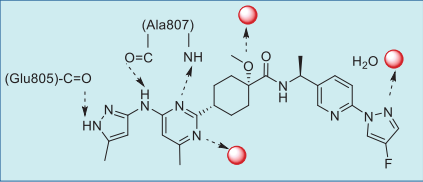| Identification | Back Directory | [Name]
BLU-667 (Pralsetinib) | [CAS]
2097132-94-8 | [Synonyms]
BLU-667
CPD2049
PRALSETINIB
PRALSETINIB (BLU667)
BLU-667 (Pralsetinib)
BLU-667;BLU 667;BLU667;2097132-94-8
(1s,4R)-N-((S)-1-(6-(4-fluoro-1H-pyrazol-1-yl)pyridin-3-yl)ethyl)-1-methoxy-4-(4-methyl-6-((5-methyl-1H-pyrazol-3-yl)amino)pyrimidin-2-yl)cyclohexanecarboxamide
(1r,4S)-N-((S)-1-(6-(4-fluoro-1H-pyrazol-1-yl)pyridin-3-yl)ethyl)-1-methoxy-4-(4-methyl-6-((5-methyl-1H-pyrazol-3-yl)amino)pyrimidin-2-yl)cyclohexanecarboxamide
Cyclohexanecarboxamide, N-[(1S)-1-[6-(4-fluoro-1H-pyrazol-1-yl)-3-pyridinyl]ethyl]-1-methoxy-4-[4-methyl-6-[(5-methyl-1H-pyrazol-3-yl)amino]-2-pyrimidinyl]-, cis-
(1r,4S)-N-((S)-1-(6-(4-fluoro-1H-pyrazol-1-yl)pyridin-3-yl)ethyl)-1-methoxy-4-(4-methyl-6-((5-methyl-1H-pyrazol-3-yl)amino)pyrimidin-2-yl)cyclohexane-1-carboxamide | [Molecular Formula]
C27H32FN9O2 | [MDL Number]
MFCD31810155 | [MOL File]
2097132-94-8.mol | [Molecular Weight]
533.6 |
| Chemical Properties | Back Directory | [Boiling point ]
799.1±60.0 °C(Predicted) | [density ]
1.40±0.1 g/cm3(Predicted) | [storage temp. ]
Store at 4°C | [solubility ]
DMSO : ≥ 100 mg/mL (187.41 mM);Water : < 0.1 mg/mL (insoluble) | [form ]
Solid | [pka]
14.33±0.10(Predicted) | [color ]
White to off-white | [InChIKey]
GBLBJPZSROAGMF-BATDWUPUSA-N | [SMILES]
[C@]1(OC)(C(N[C@H](C2=CC=C(N3C=C(F)C=N3)N=C2)C)=O)CC[C@H](C2=NC(NC3C=C(C)NN=3)=CC(C)=N2)CC1 |
| Hazard Information | Back Directory | [Description]
Pralsetinib is a potent, selective RET inhibitor, and was optimized from a hit compound identified from a compound library that included more than 60 chemical scaffolds. However, as of 2020, detailed medicinal chemistry on the optimization process has yet to be published. Pralsetinib proved to be more potent and selective than cabozantinib or vandertanib against both wild-type and abnormal RET. The agent also showed a level of selectivity against RET relative to VEGFR2, whereas previous agents showed very little selectivity. It was approved for clinical use in 2020. | [Uses]
Pralsetinib is a highly potent and selective RET inhibitor designed for RET-driven cancers. | [Indications]
Pralsetinib is the second selective RET inhibitor approved by the FDA (following Lilly's selpercatinib) for the treatment of adult patients with metastatic RET (rearranged during transfection) fusion-positive non-small cell lung cancer (NSCLC); (2) adult and pediatric patients >=12 years of age with advanced or metastatic RET-mutant medullary thyroid cancer (MTC) who require systemic therapy; and (3) adult and pediatric patients >=12 years of age with advanced or metastatic RET fusion-positive thyroid cancer who require systemic therapy and who are radioactive iodine-refractory. | [Brand name]
Gavreto | [Synthesis Reference(s)]
[1] GAIKWAD RAJENDRA. Green One-Pot Chemo-Enzymatic Synthesis of a Key Chiral Amine Intermediate: Useful to Pralsetinib Synthesis[J]. ChemistrySelect, 2023. DOI:10.1002/slct.202204409.
[2] HUGHES* D L. Review of Synthetic Routes and Crystalline Forms of the Oncology Drugs Capmatinib, Selpercatinib, and Pralsetinib[J]. Organic Process Research & Development, 2021. DOI:10.1021/acs.oprd.1c00282. | [General Description]
Class: receptor tyrosine kinase;
Treatment: RET-altered lung, thyroid cancers;
Other name: BLU-667;
Elimination half-life = 22 h;
Protein binding = 97% | [Side effects]
Pralsetinib may cause side effects: Nausea, vomiting, loss of appetite, diarrhea, constipation, extreme tiredness, dizziness, weakness, night sweats, rapid heartbeat, heartburn, shortness of breath, headache, sores in the mouth, confusion, changes in vision, fever, cough, chills, nosebleeds, pale skin, rash, itching, hives, weight changes, hair loss, back pain, muscle pain, joint pain, bone pain, unusual bruising or bleeding, blood in the urine or stool, bloody or black tarry stools, difficulty falling asleep or staying asleep, unusual vaginal bleeding, and other less common effects. | [target]
Primary target: RET | [storage]
Store at 4°C | [Mode of action]
Kinase inhibitor of wild-type RET, oncogenic RET fusions, and select mutations. Pralsetinib may also inhibit other pathways including those through FLT3, JAK1-2, PDGFRB, VEGFR-2, and FGFR1. RET fusion proteins and activating point mutations can act as oncogenic drivers by promoting cell proliferation of tumor cell lines and pralsetinib inhibits this process. |
| Questions And Answer | Back Directory | [Binding Mode]
In the co-crystal structure of pralsetinib in
complex with RET kinase (Fig. 1), the
aminopyrimidinyl and methylaminopyrazolyl
subunits fit into the adenosine pocket, forming three
critical hydrogen bonds with hinge residues Ala807
and Glu805. In addition, one pyrimidine nitrogen,
methoxy oxygen, and one fluoropyrazole nitrogen
also interact with the kinase residues indirectly via
three bound water molecules (Fig. 2).
  |
|
|